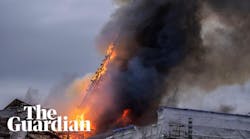LONDON, KY: NOV. 3, 1910 — The Kentucky Secretary of State Ben Bruner and former Congressman Caleb Powers just narrowly escaped death when the hotel in which they were staying became involved in what would become a major fire that swept the entire business section of the city. Both men were asleep on the upper floor of the hotel when the alarm was sounded. They escaped in their nightclothes.
CHICAGO, IL: NOV. 3, 1910 — A fast-moving fire imperiled 60 people working in a furniture factory at Wood and Clarinda streets. Fire escapes that ended at the second floor added to the danger as several people jumped to escape the smoke and flames. A sewing room foreman using an improvised rope made of webbing material lowered a woman from a second-floor window to the ground. Flames that cut off her escape down the stairs had singed her hair, but she was otherwise unharmed. The factory was a total loss.
BRANDON, MANITOBA: NOV. 5, 1910 — With blizzard conditions swirling around them, firemen responded 1½ miles outside town to find a huge insane asylum filled with flames. All of the patients had been led to safety and were huddling together in a nearby barn and other outbuildings as the huge complex burned. Several people suffered burns, but none were believed to be life-threatening.
BAYONNE, NJ: NOV. 9, 1910 — Tank 8 of the Tide Water Oil Co. in Constable Hook exploded a few minutes after 6 P.M. The tank, which contained about 40,000 barrels of kerosene, was in the middle of the yard and surrounded by steam stills and other tanks. The oil company's fire brigade responded, backed up by the Standard Oil Co. fire crew. The force of the blast was so strong it killed one worker instantly, throwing his body over 200 feet. The explosion also broke plate-glass windows along Broadway almost to the Jersey City line. Fire conditions became so severe after a half-hour, the Bayonne Fire Department was called to help protect exposed tanks and extinguish the main blaze.
NEW YORK CITY: NOV. 11, 1910 — Fire was discovered in the main building of the Catholic Protectory on Unionport Road in the Bronx at about 11 P.M. The fire broke out in the bakery in the cellar. Eighteen hundred boys were sleeping in the dormitories on the four floors above and the school staff hurried to evacuate all the children. Responding engines became bogged down in mud and four alarms were transmitted as the fire intensified. Despite brisk winds, low water pressure and the poor country roads leading to the school, the fire was brought under control by midnight.
NEW YORK CITY: NOV. 12, 1910 — Seven of the 12 firemen working in Engine 18 (a high-pressure hose wagon) were overcome by dense smoke during a cellar fire in a six-story tenement at 24 Cornelia St. in Greenwich Village. Led by Captain Charles W. Rush, they pried open an iron grating and descended into the cellar. Flames were seen around large woodbins in the center of the cellar and the area was being blanketed with a stifling smoke condition. Before water could be started in their line, the heat became so intense that the connections of the gas meters began to melt and the gas mixed with the already debilitating smoke. Members feeding hose into the cellar realized their comrades were in trouble and descended to locate them. Several firemen returned dragging or carrying unconscious men as other would-be rescuers joined the already downed men in unconsciousness. Rush called for the new smoke helmet and went in search of his men. Fireman Walter McBride appeared carrying an unconscious man and soon dropped to the sidewalk, overcome by smoke. Rush removed two unconscious men as Lieutenant Joseph Bonk of Engine 30, without the benefit of breathing apparatus, made the deepest plunge into the smoke-filled cauldron and rescued Fireman Charles Murphy from sure death.
NEWARK, NJ: NOV. 26, 1910 — Around 9:30 in the morning, 116 girls and an errand boy were at work on the top floor of the four-story factory at High and Orange streets. On the floor below, in the Anchor Lamp Co., a young woman was carbonizing light bulb filaments. During her operation, flames broke out and attempts to control the fire with pails of sand proved useless. A girl raced across the street to a firehouse for help. A captain and firemen hurried back with fire extinguishers. The captain smashed a window and yelled across the street for the men to transmit the box. Meanwhile, no alarm had been sounded on the floor above, but the women were now aware of the fire below them. With inadequate fire escapes and only one tight wooden staircase, the women were trapped. Firemen struggled to put ladders and life nets in place as the women above started jumping. Many girls were rescued or escaped. When the fire was extinguished, the damage was clear: six girls had burned to death, 19 had jumped to their deaths and more than 40 were injured.
PAUL HASHAGEN, a Firehouse® contributing editor, is a retired FDNY firefighter who was assigned to Rescue 1 in Manhattan. He is also an ex-chief of the Freeport, NY, Fire Department. Hashagen is the author of FDNY: The Bravest, An Illustrated History 1865–2002, the official history of the New York City Fire Department, and other fire service books. His latest novel, Fire of God, is available at www.dmcfirebooks.com.





